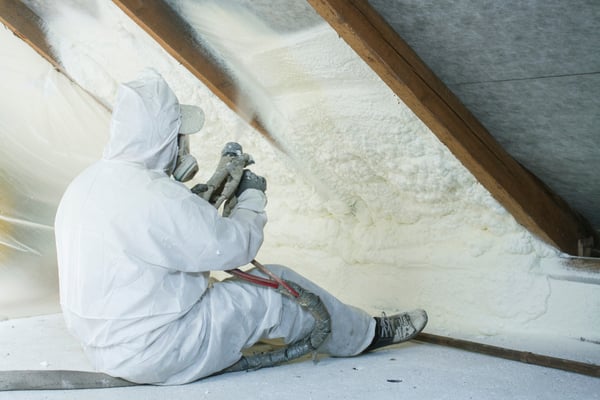Overview on Top 4 Types of Roofing Insulation Methods 2023

Roof insulation methods are divided into three categories: rigid board, non-rigid, and sprayed polyurethane foam. Rigid boards are commonly used in low-slope assemblies, and some common insulation materials are polyisocyanurate, extruded polystyrene and mineral wool. Non-rigid insulation is mostly used for attic spaces and pre-engineered buildings.
In New York City, all new roofs and existing roof expansions are subject to Local Laws 92 and 94. These laws require a sustainable roofing system, which can be either a green roof or solar panels.
Cover Boards
Cover boards are thin layers of insulation, such as wood fiberboard, perlite, dense polyisocyanurate and glass-mat gypsum. Cover boards are placed over the primary thermal insulation to enhance its physical properties:
- Improved fire resistance
- Compressive strength
- Protection from roof foot traffic
- Preventing blistering and shrinkage
- Wind uplift resistance
- Improved compatibility.
Cover boards are also used in reroofing to improve the application surface. They cover joints between insulation boards, and provide a separation layer between the existing and new roof membranes.
Rigid Insulation Boards
Rigid insulation boards, also known as board-stock insulation, provide enough compressive strength to support the roof membrane and its loads. Besides providing support for the roof membrane, rigid insulation also supplies a uniform surface for membrane application and enhanced hail resistance. Here is a list of the common types of rigid insulation boards available:
Perlite: An open-cell low R-value insulation used as a cover board, which provides good fire resistance but loses compressive strength when exposed to water. 1/2" boards have a greater percentage of organic material compared with thicker boards. When hot asphalt is used it can cause blistering, and for this reason perlite is generally not recommended.
Polyisocyanurate: A high R-value plastic foam insulation used in low-slope roofs. It has a higher resistance to fire compared with polystyrene, but this should be verified with manufacturers if a thermal barrier is required. Polyisocyanurate insulation always comes with facers, thin sheets on both faces, since they are necessary in the production process. When subject to high traffic, foam insulation can compress and facers can delaminate. Polyisocyanurate will absorb moisture when exposed to a leaks. This causes the insulation to lose its R-value, making a replacement necessary, unlike polystyrene which can be reused. Note that polyisocyanurate is less expensive than extruded polystyrene.

Composite boards: Composite boards are made of two layers of different insulation types, which are laminated together in a factory. The main insulation is usually polyisocyanurate or EPS; and the second layer can be perlite, plywood, wood fiberboard or gypsum board. Typically, the secondary layer will be the top surface of the board. Having a strong mechanical attachment between both layers is crucial, or otherwise the secondary layer can fall off.
Polystyrene: There are two types of polystyrene insulation, expanded polystyrene (EPS) and extruded polystyrene (XPS), each with unique properties. Polystyrene is a type of plastic foam, therefore it should be used with caution in situations where hot roofing materials are employed.
- Expanded Polystyrene (EPS): EPS is sometimes referred to as bead-board or molded expanded polystyrene, and it is a low-density product with moderate R-value. EPS does not provide high water vapor resistance, and will disintegrate when exposed to solvent-based adhesives and hot asphalt. If any of these materials is used, a cover board needs to be installed over the insulation. Unlike other plastic foam insulations, EPS will not thermally age since its cells are filled with air.
- Extruded Polystyrene (XPS): Extruded polystyrene has a high R-value and good resistance against water vapor. However, similar to EPS, it should not be exposed to hot asphalt, solvents or extremely high temperatures. Compared with polyisocyanurate, XPS offers the possibility of reuse since it does not absorb water. XPS insulation also has a lower life cycle cost than polyisocyanurate insulation.
Blanket, Batt, and Blown-In Insulation
This insulation is commonly used for attic spaces and roofs of pre-engineered metal buildings. Batt insulation is factory-cut into standard lengths and bundled without rolling, while blanket insulation comes in rolls. The most common material for batt and blanket insulation is fiberglass, which is also available as a blown-in product. Other materials include mineral wool, which has higher compressive strength than fiberglass; and cellulose from recycled newsprint, which is available for blown-in insulation and can be treated to resist fire and mold.

Sprayed Polyurethane Foam Insulation
Sprayed polyurethane foam (SPF) insulation systems are self-adhering, two-component materials. They are directly applied to roof decks, and can serve as insulation and air barrier when applied to the underside. SPF insulation is available in closed-cell or open-cell versions, with different levels of vapor permeability. It can be used by itself, or as a primary roof covering in combinations of protective coatings.

Anuj Srivastava
Anuj Srivastava is a principal partner at NY Engineers. He is known for his MEP franchise market knowledge. Anuj is currently leading a team of 100+ MEP/FP engineers and has successfully led over 1500 franchise projects in the US.
Join 15,000+ Fellow Architects and Contractors
Get expert engineering tips straight to your inbox. Subscribe to the NY Engineers Blog below.


